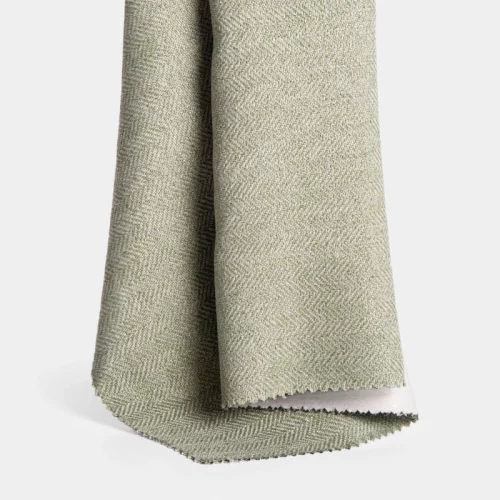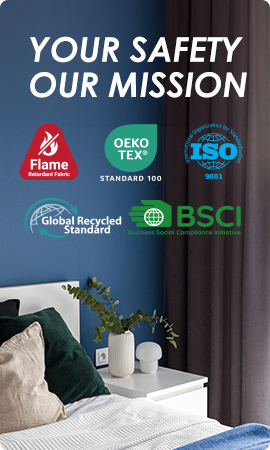Flame retardant Manufacturer Strategy: From Standard Interpretation to Manufacturer Screening
Standards for Flame Retardant Fabric Manufacturers
Selecting the manufacturers of flame retardant products is equally essential. Because it can ensure home safety standards and regulations. Selecting manufacturers for these products comes with requirements like effectiveness and longevity of their utilized materials, their adherence to environmental and safety standards and their verification process.
Material Durability and Performance
Flame retardant fabric is designed to prevent burning and retard flame spread when a fire erupts in a particular area. In the process of choosing a manufacturer of such fabric for your application, it is important to study the power and performance of their product. Durable flame retardant fabrics (such as polypropylene fibers or phosphate-based flame retardant-treated fabrics) can remain stable after 50 standard washes. For example, after 10 times of washing and 100 times of friction, the ultimate oxygen index (LOI) can still be maintained at more than 26% while the oxygen index (OI) of cotton-based durable flame retardant fabric is still greater than 32% after 50 times of soap washing in line with GB8624-1997 flame retardant material B1 standard.
Environmental and Safety Considerations
Manufacturers need to adhere to environmental safety regulations. So it can reduce the environmental impact because of their manufacturing operation. This needs to use environmentally friendly chemicals in fabric treatment and the adoption of green systems in waste management. BEGOODTEX can stress ecological safety. It produced the fabrics by consuming 30% less water and 20% less carbon emission than the average of the textile industry. BEGOODTEX also produced the fabrics by eliminating the need to add chemical flame retardant, reducing the occurrence of fires by 25%. It uses 100% cotton and 100% viscose to make the world more safe and eco-friendly.
Process Verification
Regular checks and quality control procedures can ensure that fire-resistant fabrics adhere to the required safety regulations. Manufacturers must follow testing procedures during production. Because it needs to validate the efficiency of their fire retardant treatments. Third-party certifications are crucial for verifying compliance with global safety standards. Consumers can trust products from manufacturers with process verification systems. The verification can make the fabric dependable and safe.
Global Landscape of Flame Retardant Fabric Manufacturers
The flame retardant fabric industry is shaped differently around the world as manufacturers in regions adhere to distinct standards and regulations.
United States Standards
American producers of flame retardant fabrics are required to meet the standards of organizations like the National Fire Protection Association (NFPA) and the American Society for Testing and Materials (ASTM). They define performance requirements for fire resistance. The tests can replicate actual fire situations. It ensures that fabrics used in households offer proper protection against fire risks.
European Standards
European fire textile standards are governed by bodies such as the European Committee for Standardization (CEN). A case in point is the EN 1021 standard. The standard specifies the demands for determining how upholstered furniture ignites from a cigarette or a match flame simulation. Such standards concentrate on environmentally friendly production processes. So it can achieve environmental sustainability.
Chinese Standards
China is adopting a national standard such as GB 20286-2006. The standard delineates technical requirements for flame-resistant clothing in public areas. Local manufacturers are emphasizing more on research and development and quality enhancement. The development meets local as well as foreign demand. Growing emphasis on R&D activities upgrades manufacturing processes. Its final aim is to maximize the performance of fabric at no sacrifice of cost.
Technological Innovations from Traditional to Green Methods in Manufacturing
The way flame retardant fabrics are made has changed a lot. Because technologies focus more on sustainability rather than traditional methods.
Ammonia Fuming Method
The ammonia fuming technique is a standing method. It can be employed for imparting flame resistant properties to textiles. This process includes treating fabrics with gas. So the gas can interact with specific chemicals used in the treatment process. The process boosts the fabric’s resistance to fire.
Nano Flame Retardants
Advancements in nano technology have developed highly effective flame retardants on a tiny scale. These nano flame retardants deliver performance by performing fire resistance.
Plant Extracts
To make fabrics in flame retardancy, researchers tried to use plant extracts as natural substitutes. Compounds in one of the plants can help slow down fires. This not reduces the need for man made chemicals but also helps in sustainability. Because it can use resources that can be replenished over time.
Formation of Insulating Layers
Creating methods also includes making insulating layers in clothing. The insulation blocks heat transfer when there is a fire nearby. This barrier helps protect the fabric from catching fire. At the same time, it still keeps it strong in heat situations. This way of working shows how smart engineering can be. It makes safety feature better without losing comfort or practicality.
Consumers can make informed choices when choosing a trustworthy fire retardant fabric manufacturer. They prioritize safety and sustainability by considering standards compliance across different regions and technological progress.
The Need for Screening Flame Retardant Fabric Manufacturers
It’s important to select manufacturers of flame retardant fabrics to guarantee the safety and functionality of household products.
Diverse Applications
Flame retardant materials are commonly used in homes for upholstery fabrics like curtains. Bedding protects against fire hazards such as cigarettes or electrical issues over time. Various household applications require specific performance features. So it can guarantee fire safety measures are in place. This means choosing manufacturers who can create different custom fabrics.
Production of Low-Toxicity Flame Retardants
With the rising concern for health and the environment, flame resistant fabrics need safer chemicals that have minimal toxicity levels. Manufacturers need to create formulas that reduce emissions. And also it has to keep the fire resistant features intact. The difficulty lies in attaining fire retardation without jeopardizing human well-being or adding to environmental harm. Manufacturers must prioritize eco-friendly production methods to meet current safety guidelines effectively.
Balancing Safety with Skin-Friendly Properties
Flame-resistant fabrics should do more than shield against fires. They should also be cozy and harmless for regular wear and tear. It needs right mix of fireproof treatments and skin-friendly features. So it can keep irritation and allergies at bay while staying safe from flames in style. Manufacturers have to pick materials and methods that strike this balance. So they can make sure their products are both protective and comfortable for everyday use.
Reasons to Choose BEGOODTEX as a Flame Retardant Fabric Manufacturer

BEGOODTEX is a standout choice among fabric manufacturers. They are in search of dependable flame retardant fabric options. They focus on top-notch quality and groundbreaking ideas that shine through various crucial elements.
Use of Permanent Flame Retardant Materials
BEGOODTEX incorporates flame-retardant materials that retain their safety features for the entire lifespan of the fabric. Its product can wear off with time or exposure to sunlight and washing cycles. This consistent reliability makes BEGOODTEX a choice among consumers. It can meet the needs of the consumer for their home textiles.
Comfort Features
BEGOODTEX not only focuses on safety but also puts a strong emphasis on providing comfort. So their fabrics enjoy features like breath and softness. This approach aims to improve user satisfaction because it can offer a tactile sensation while ensuring fire protection. Meeting consumer demands for top-notch home textiles involves balancing both safety and comfort aspects.
Environmentally Friendly Production and Sustainable Development
At BEGOODTEX, they prioritize conscious production methods that align with sustainable development objectives. They incorporate eco-friendly practices at every stage of their manufacturing processes. They starts to utilize renewable materials to reducing waste output. This strong commitment to sustainability not lessens the ecological footprint but also resonates with consumer demand for eco-friendly goods.
Rigorous Fire Testing and Certification
BEGOODTEX ensures that all its products meet safety standards through thorough fire testing procedures. It is a part of their commitment to quality assurance measures. They also obtain certifications from reputable third-party organizations to instill confidence in consumers. So their fabrics can be reliable and efficacy. This solidifies their reputation as a reputable manufacturer within the industry.
By grasping these elements, BEGOODTEX can apply to different industries. At the same time, They maintains a delicate balance between safety and comfort. Acknowledging reputable companies such as BEGOODTEX in the textile industry sector gives consumers the ability to make well-informed decisions. They can choose flame resistant fabric suppliers that value safety and eco-friendly feature in their products.
FAQ
Q: What international standards do flame retardant fabric manufacturers need?
A: Manufacturers of flame retardant fabrics typically adhere to industry standards like EN 11611 and EN 11612 in the EU and NFPA 2113 along with NFPA 70 E and UL 94 in America.
Q: What techniques do flame retardant fabric manufacturers have for producing flame retardant fabrics?
A: The manufacturing process for flame fabric encompasses various stages such as selecting materials and applying chemical treatments. It also involves a process that includes developing flame resistant fibers and blending them together. They used fiber blending technology. Additionally, coating and impregnation processes are utilized along with flame retardant finishes.

